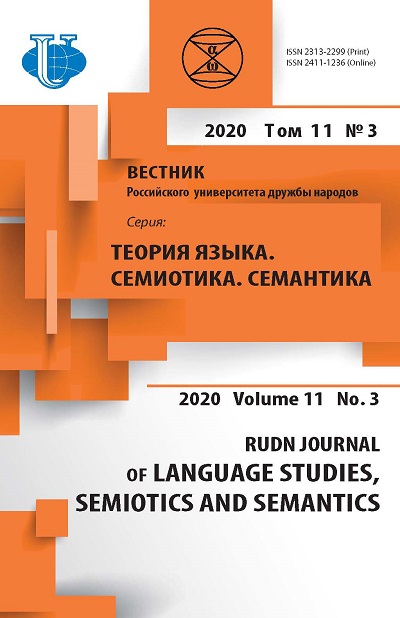Universal and Culturally Specific Features and Linguistic Peculiarities of the Political Cartoon in the Arabic and French Languages
- Authors: Dugalich N.M.1
-
Affiliations:
- Peoples’ Friendship University of Russia (RUDN University)
- Issue: Vol 11, No 3 (2020)
- Pages: 479-495
- Section: COGNITIVE STUDIES IN LANGUAGE
- URL: https://journals.rudn.ru/semiotics-semantics/article/view/24601
- DOI: https://doi.org/10.22363/2313-2299-2020-11-3-479-495
- ID: 24601
Cite item
Full Text
Abstract
The article discusses the universal and culturally-specific features and linguistic means of the political cartoon in the Arabic and French languages. Political cartoon is a universal tool for political dialogue between government and society, a reflection or reaction of society to a certain political event, series of events, or a person of national or world level. The goals and objectives of political cartoon, its mechanism of influence on the addressee, and its genre identity have a common tradition and common components. The study of the phenomenon of a political cartoon in various linguistic cultures is an area of relevant multidisciplinary research, primarily because the author’s creative principle at the level of text and drawing interacts in the political cartoon with tradition and its genre framework, producing a capacious multilayer creolized text, the decoding of which requires from the addressee the presence of linguistic, logical and extralinguistic (primarily political and historical) presuppositions and the skills to analyze it. The object of the proposed work is a modern political cartoon in Arabic and French. The subject of the research is structural, lexical-semantic, pragmatic and cultural-specific characteristics of the creolized text of a political cartoon in the Arabic and French languages. The purpose of the work is to identify universal and culturally specific features of a cartoon on a political leader or an event at the iconic and verbal level in each of the languages under consideration. For the first time in Russian linguistics the presented study carries out a comparative analysis of the political cartoon in the Arabic and French languages and describes its universal features and cultural-specific peculiarities.
About the authors
Natalia M. Dugalich
Peoples’ Friendship University of Russia (RUDN University)
Author for correspondence.
Email: dugalich-nm@rudn.ru
PhD in Philology, associate professor of the Department of Foreign Languages of the Philological Faculty
6, Miklukho-Maklaya str., Moscow, Russian Federation, 117198References
- Bart, R. (1989). Selected Works. Semiotics. Poetics. Moscow. (In Russ.).
- Bakhtin, M.M. (1996). From archival records to the “Problem of Speech Genres”. Moscow: Russ.kie slovari. pp. 159-207. (In Russ.).
- Eco, U. (1998). The missing structure. St. Petersburg: Petropolis4. (In Russ.).
- Lotman, Yu.M. (1999). Text as a meaning-generating device In Inside the thinking worlds. Man - Text - Semiosphere - History. Moscow: Languages of Russian Culture. pp. 11-163.
- Stepanov, Yu.S. (1971). Semiotics. Moscow: Nauka. (In Russ.).
- Sternin, I.A. (2004). Cognitive interpretation in linguistic-cognitive research. Issues of Cognitive Linguistics, 1, 65-69. (In Russ.).
- Vezhbitska, A. (1996). Language. The culture. Cognition. Moscow: Russ.kie slovari. (In Russ.).
- Anisimova, E.E. (2003). Linguistics of the text and intercultural communication (based on creolized texts). Moscow: Academia. (In Russ.).
- Bernatskaya, A.A. (2000). To the problem of “creolization” of the text: history and current state. Speech communication, 3 (11), 104-110. (In Russ.).
- Matulevich, T.G. (2017). The creolized announcement on The Economist magazine cover. RUDN Journal of Language Studies, Semiotics and Semantics, 8 (4), 383-846. (In Russ.).
- Sorokin, Yu.A. & Tarasov, E.F. (1990). Creolized texts and their communicative function In Optimization of speech exposure. Moscow. pp. 180-186. (In Russ.).
- Voroshilova, M.B. (2007). Creole Text: Aspects of Learning. Political Linguistics, 21 (1), 75-80. (In Russ.).
- Reem, A.L. & Sharifah, N.H.A. (2019). A Cross-Cultural Study of Persuasive Strategies in Relationship Advice Articles in Women’s Magazines. Journal of Language Studies, 19 (2), 15-32.
- Maslova, V.A. (2008). Political discourse: language games or word games? Political linguistics, 24 (1), 43-48. (In Russ.).
- Selivanova, E.A. (2002). Fundamentals of the linguistic theory of text and communication: Monographic textbook. Kiev: TSUL, Phytosociocenter. (In Russ.).
- Shakhovsky, V.I., Sorokin, Yu.A. & Tomasheva, I.V. (1998). The text and its cognitive-emotive metamorphoses (intercultural understanding and linguoecology). Volgograd: Peremena. (In Russ.).
- Vereshchagin, E.M. & Kostomarov, V.G. (1990). Language and culture. Linguistic studies in the teaching of Russian as a foreign language. Moscow: “Russ.kij jazyk”. (In Russ.).
Supplementary files












